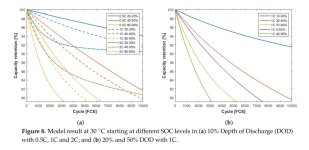geekmystique
10 µW
- Joined
- Jul 27, 2019
- Messages
- 5
First off, thanks to all in this forum for the endless discussions and information.
Now is my time to share back.
How to properly treat a cell and have as much use out of it is my favorite discussion topic here.
I stumbled upon a very interesting scientific study with well controlled parameters, with the focus on lithium battery degradation for EVs;
https://mediatum.ub.tum.de/doc/1355829/file.pdf
much of this information can be also applied for smaller applications like ebikes and even rc.
The cell tested is:
Panasonic NCR18650PD (NCA type)
I would expect the lessons learned here to at least transfer to other NCA cells but also other chemistries to some extent.
Some new takeaways for me (reading as layman) are:
Already very well known but confirmed:
From this I take the following lessons for my Ebike:
Hope this was helpful and/or interesting! Looking forward to more discussion

 !
!
Now is my time to share back.
How to properly treat a cell and have as much use out of it is my favorite discussion topic here.
I stumbled upon a very interesting scientific study with well controlled parameters, with the focus on lithium battery degradation for EVs;
https://mediatum.ub.tum.de/doc/1355829/file.pdf
much of this information can be also applied for smaller applications like ebikes and even rc.
The cell tested is:
Panasonic NCR18650PD (NCA type)
I would expect the lessons learned here to at least transfer to other NCA cells but also other chemistries to some extent.
Some new takeaways for me (reading as layman) are:
- If sensibly used, NCA cells should last well over 10 years and over 1000 cycles with still around 80% original capacity left (WOOHOO)
- Higher charging currents (in this case starting already > 1a!) DRAMATICALLY increase degradation, everything below 1a has little further positive effect.
- At 10c cell degradation is much higher than at 25c, both in charge and discharge. Higher temps during charge and discharge are not detrimental
- Peaking of discharge current vs constant current draw degradation is similar; i.e. some load spikes when pumping an ebike should not hurt too much as long as it is not a constant state.
Already very well known but confirmed:
- Lower storage temperature and lower storage SoC decrease degradation
- Lower charge end voltage decreases degradation (pretty big differences also between 3.7, 4.0 and 4.1 volts)
- Lower depth of discharge increases life considerably.
From this I take the following lessons for my Ebike:
- I will set my charger end voltage between 4.0 or 4.1 volts and charge whenever I arrive home, less deep discharge is better and with a conservative end voltage the degradation due to storage is not so bad. Only for a big trip I charge it up to 4.2
- Leave the bike half discharged (ie. around 3.6v) if not in use for some time
- Use 1a charging current or lower (per cell, so for 3p, 3a max, etc) if i have the time
- In winter charge with even less amps (pack is outside), do not charge at all below 0c
Hope this was helpful and/or interesting! Looking forward to more discussion



